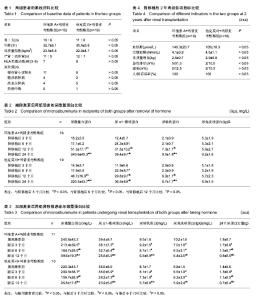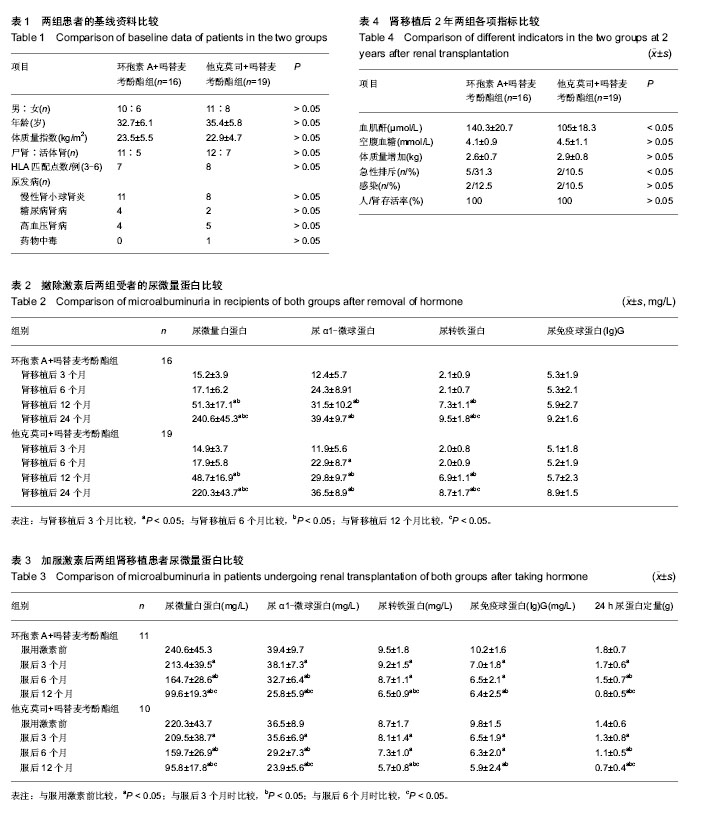Chinese Journal of Tissue Engineering Research ›› 2014, Vol. 18 ›› Issue (36): 5770-5775.doi: 10.3969/j.issn.2095-4344.2014.36.006
Previous Articles Next Articles
Removal of glucocordicoids influences the occurrence of microalbuminuria in recipients receiving renal transplantation
Zuo Fu-jie1, Wang Li-ming2, Feng Xiao-fang3, Min Min3, Han Shu2
- 1Department of Nephrology, Shanghai People’s Hospital of Pudong New Area, Shanghai 201200, China
2Organ Transplant Center, Shanghai Changzheng Hospital, Shanghai 200003, China
3Department of Kidney Transplant Rehabilitation, Shanghai Zhabei District Central Hospital, Shanghai 200070, China
-
Revised:2014-06-01Online:2014-08-30Published:2014-08-30 -
Contact:Wang Li-ming, M.D., Chief physician, Organ Transplant Center, Shanghai Changzheng Hospital, Shanghai 200003, China -
About author:Zuo Fu-jie, Attending physician, Department of Nephrology, Shanghai People’s Hospital of Pudong New Area, Shanghai 201200, China
CLC Number:
Cite this article
Zuo Fu-jie, Wang Li-ming, Feng Xiao-fang, Min Min, Han Shu. Removal of glucocordicoids influences the occurrence of microalbuminuria in recipients receiving renal transplantation[J]. Chinese Journal of Tissue Engineering Research, 2014, 18(36): 5770-5775.
share this article

2.1 参与者数量分析 由专人对患者临床资料进行调查、分析,无脱落例数,合格率100%。 2.2 两组一般情况比较 两组患者的人口统计学特征、配型等差异均无显著性意义,两组具有可比性(表1)。 2.3 撤除激素后两组患者的尿微量蛋白比较 肾移植后3个月尿微量蛋白恢复至正常水平。肾移植后6个月,尿α1-微球蛋白开始升高(P < 0.05),而尿微量白蛋白、尿免疫球蛋白(Ig)G、尿转铁蛋白无明显变化(均为P > 0.05)。肾移植后12个月,尿微量白蛋白、尿α1-微球蛋白、尿转铁蛋白明显升高(均为P < 0.05)。肾移植后24个月,尿微量白蛋白、尿α1-微球蛋白、尿转铁蛋白、尿免疫球蛋白(Ig)G均明显升高(均为P < 0.05,表2)。两组同一时间段尿微量蛋白比较差异无显著性意义(均为P > 0.05)。 尿蛋白阳性:肾移植后3个月0例;肾移植后6个月,环孢素A组弱阳性1例(6.3%),他克莫司组0例;肾移植后12个月,环孢素A组阳性5例(31.3%),他克莫司组3例(15.8%);肾移植后24个月,环孢素A组阳性11例(68.8%),他克莫司组10例(52.6%)。 2.4 加服激素(泼尼松)后两组患者的尿微量蛋白比较 服用激素(泼尼松)后3个月,尿微量白蛋白开始下降(P < 0.05),而尿α1-微球蛋白、尿免疫球蛋白(Ig)G、尿转铁蛋白、24 h尿蛋白定量无明显变化(均为P > 0.05)。服后激素6个月,尿微量白蛋白、尿α1-微球蛋白进一步下降(均为 P < 0.05)。加服激素后12个月,尿微量白蛋白、尿α1-微球蛋白、尿转铁蛋白、24 h尿蛋白定量均下降(均为P < 0.05),而尿免疫球蛋白(Ig)G无明显变化(P > 0.05,表3)。 两组同一时间段尿微量蛋白比较差异无显著性意义(均为P > 0.05)。 尿蛋白阳性:服后3个月,环孢素A组仍11例,他克莫司组仍10例;服后6个月,环孢素A组10例(62.5%),他克莫司组9例(47.4%);服后12个月,环孢素A组9例(56.3%),他克莫司组7例(36.8%)。 2.5 肾移植后2年两组各项指标比较 肾移植后2年,环孢素A组血肌酐水平、急性排斥率高于他克莫司组(P < 0.05),空腹血糖、体质量增加、感染及人/肾存活率均无明显差异(P > 0.05,表4)。"

| [1] Hoban R, Gielda B, Temkit M,et al.Utility of HbA1c in the detection of subclinical post renal transplant diabetes. Transplantation. 2006;81(3):379-383. [2] Ahmadpoor P, Reisi S, Makhdoomi K,et al.Osteoporosis and related risk factors in renal transplant recipients.Transplant Proc. 2009;41(7):2820-2822. [3] Giakoustidis D, Antoniadis A, Fouzas I, et al.Prevalence and clinical impact of cytomegalovirus infection and disease in renal transplantation: ten years of experience in a single center. Transplant Proc. 2012;44(9):2715-2717. [4] 陈国标,陈立中,陈白莉,等.低剂量激素方案在肾移植中应用的疗效和安全性[J].中华肾脏病杂志,2009,25(12):948-949. [5] 刘双德,王洪伟,田川,等.中老年肾移植患者早期撤除激素的免疫抑制方案研究[J].中华老年医学杂志,2010,29(1):42-45. [6] Knight SR, Morris PJ.Steroid avoidance or withdrawal after renal transplantation increases the risk of acute rejection but decreases cardiovascular risk. A meta-analysis. Transplantation. 2010;89(1):1-14. [7] Pascual J, Galeano C, Royuela A,et al.A systematic review on steroid withdrawal between 3 and 6 months after kidney transplantation.Transplantation. 2010;90(4):343-349. [8] Sprangers B, Vanrenterghem Y.Steroid avoidance or withdrawal after kidney transplantation: a balancing act. Transplantation. 2010;90(4):350-352. [9] Knight SR, Morris PJ.Steroid avoidance or withdrawal in renal transplantation. Transplantation. 2011;91(5):e25-27. [10] Zhang X, Huang H, Han S, et al. Is it safe to withdraw steroids within seven days of renal transplantation. Clinical Transplantation. 2013;27(1):1-8. [11] 眭维国.高致敏人群肾移植急性排斥反应的综合预防[J].器官移植内科学杂志,2012,7(4):162-165. [12] 郭义峰.肾移植术后急性排斥反应的治疗和预防[J].中华临床医师杂志:电子版,2013,7(1):6-7. [13] Halloran PF. Immunosuppressive drugs for kidney transplantation. N Engl J Med. 2004;351(26):2715-2729. [14] 武国军,王禾,于磊,等.联合霉酚酸酯、环孢素A和泼尼松应用于肾移植患者免疫抑制治疗[J].中国现代医学杂志,2006,16(17): 2640-2642. [15] 韦星,蔡明,李州利,等. 甲泼尼龙治疗肾移植后的重症肺部感染[J].中国组织工程研究,2014,18(5):742-747. [16] Pascual J, van Hooff JP, Salmela K,et al.Three-year observational follow-up of a multicenter, randomized trial on tacrolimus-based therapy with withdrawal of steroids or mycophenolate mofetil after renal transplant.Transplantation. 2006;82(1):55-61. [17] Nowacka-Cieciura E, Soluch L, Cieciura T,et al.Effect of glucocorticoid-free immunosuppressive protocol on serum lipids in renal transplant patients.Transplant Proc. 2000; 32(6):1339-1343. [18] Pascual J, Zamora J, Galeano C,et al.Steroid avoidance or withdrawal for kidney transplant recipients. Cochrane Database Syst Rev. 2009;(1):CD005632. [19] 刘双德,王洪伟,田川,等.中老年肾移植患者早期撤除激素的免疫抑制方案研究[J].中华老年医学杂志,2010,29(1):42-45. [20] 张益民,李幼姬.肾移植后不用或撤除糖皮质激素的利弊[J].中国中西医结合肾病杂志,2010,11(3):191. [21] 曲青山,蔡文利,苗书斋,等.撤除激素的肾移植免疫抑制方案研究[J].医药论坛杂志,2006,27(9):23-24. [22] Woodle ES, Peddi VR, Tomlanovich S,et al.A prospective, randomized, multicenter study evaluating early corticosteroid withdrawal with Thymoglobulin in living-donor kidney transplantation.Clin Transplant. 2010;24(1):73-83. [23] Sandrini S, Setti G, Bossini N,et al.Early (fifth day) vs. late (sixth month) steroid withdrawal in renal transplant recipients treated with Neoral(®) plus Rapamune(®): four-yr results of a randomized monocenter study.Clin Transplant.2010;24(5):669-677. [24] Tan JY, Zhao N, Wu TX,et al.Steroid withdrawal increases risk of acute rejection but reduces infection: a meta-analysis of 1681 cases in renal transplantation.Transplant Proc. 2006; 38(7):2054-2056. [25] Vincenti F, Monaco A, Grinyo J,et al.Multicenter randomized prospective trial of steroid withdrawal in renal transplant recipients receiving basiliximab, cyclosporine microemulsion and mycophenolate mofetil.Am J Transplant.2003;3(3):306-311. [26] Gelens MA, Christiaans MH, van Heurn EL,et al.High rejection rate during calcineurin inhibitor-free and early steroid withdrawal immunosuppression in renal transplantation. Transplantation. 2006;82(9):1221-1223. [27] Laftavi MR, Stephan R, Stefanick B,et al.Randomized prospective trial of early steroid withdrawal compared with low-dose steroids in renal transplant recipients using serial protocol biopsies to assess efficacy and safety.Surgery. 2005; 137(3):364-371. [28] 刘龙山,刘岩峰,邓荣海,等. 肾移植后稳定期受者撤除皮质激素的临床研究[J].中华器官移植杂志,2013,34(11):643-646. [29] 姜伟,刘彦斌,裴向克,等.肾移植术后重症肺炎撤除免疫抑制剂治疗的安全性评估[J].实用器官移植电子杂志,2013,1(4):229-231. [30] 张晓君,蒲晓煜,陈国勇,等.免疫抑制剂撤除治疗肝移植术后重症感染[J].中华普通外科杂志,2012,27(11):927-930. [31] Favi E, Spagnoletti G, Salerno MP,et al.Tacrolimus plus mycophenolate mofetil vs. cyclosporine plus everolimus in deceased donor kidney transplant recipients: three-yr results of a single-center prospective clinical trial.Clin Transplant. 2013; 27(4):E359-367. [32] Cooper M, Salvadori M, Budde K,et al.Enteric-coated mycophenolate sodium immunosuppression in renal transplant patients: efficacy and dosing.Transplant Rev (Orlando). 2012;26(4):233-240. [33] Khalkhali HR, Ghafari A, Hajizadeh E,et al.Risk factors of long-term graft loss in renal transplant recipients with chronic allograft dysfunction.Exp Clin Transplant. 2010;8(4):277-282. [34] 林超萍,潘洁茹,吕婉娴.血清胱蛋白酶抑制剂c在肾移植中的临床意义[J].实用医技杂志,2008,15(9):1096-1097. [35] Andersson L, Haraldsson B, Johansson C,et al. Methodological issues on the use of urinary alpha-1-microglobuline in epidemiological studies.Nephrol Dial Transplant. 2008;23(4):1252-1256. [36] Groggel C,Stevenson J,Hovingh P,et al.Changes in heparin sulfate correlate with increased glomerular permeability. Kidney International.1988;33(2):517-523. [37] 黎磊石.中国肾移植手册[M].Philadelphia:Lippincott Williams &Wilkins,2005:205. [38] Pascual M, Theruvath T, Kawai T,et al.Strategies to improve long-term outcomes after renal transplantation.N Engl J Med. 2002;346(8):580-590. [39] 吴斌,苏兰,徐珽,等.他克莫司替代环孢素A防治移植物抗宿主病的Meta分析[J].中国医院药学杂志,2009,29(22):1957-1959. [40] Krämer BK, Klinger M, Wlodarczyk Z, et al.Tacrolimus combined with two different corticosteroid-free regimens compared with a standard triple regimen in renal transplantation: one year observational results.Clin Transplant. 2010;24(1):E1-9. [41] Rostaing L, Cantarovich D, Mourad G, et al. Corticosteroid-free immunosuppression with tacrolimus, mycophenolate mofetil, and daclizumab induction in renal transplantation.Transplantation. 2005;79(7):807-814. [42] Bowman LJ, Brennan DC.The role of tacrolimus in renal transplantation.Expert Opin Pharmacother. 2008;9(4):635-643. [43] Yong K, Nguyen HD, Hii L,et al.Association of a change in immunosuppressive regimen with hemodynamic and inflammatory markers of cardiovascular disease after kidney transplantation.Am J Hypertens. 2013;26(7):843-849. [44] 邹贵勉, 眭维国,晏强,等.肾移植后高尿酸血症对移植肾远期功能的影响[J].解放军医学杂志, 2009,34(9):1108-1110. [45] Wang W, Li XB, Yin H,et al.Factors affecting the long-term renal allograft survival.Chin Med J (Engl). 2011;124(8): 1181-1184. [46] Huscher D, Thiele K, Gromnica-Ihle E, et al.Dose-related patterns of glucocorticoid-induced side effects. Ann Rheum Dis. 2009;68(7):1119-1124. [47] 王建功.糖皮质激素受体及其在器官移植排斥反应中的作用[J].实用医药杂志,2004,21(6):570-572. [48] Perogamvros I, Ray DW, Trainer PJ.Regulation of cortisol bioavailability--effects on hormone measurement and action.Nat Rev Endocrinol. 2012;8(12):717-727. |
| [1] | Wang Xiaobo, Wang Changan, Han Jianle, Yang Qingyan, Yang Shuaiping, Yang Junwei. Influence of conversion from cyclosporine to tacrolimus on glucose metabolism and cardiovascular risk profiles in stable kidney transplant patients [J]. Chinese Journal of Tissue Engineering Research, 2021, 25(14): 2236-2240. |
| [2] | Liu Junchang, Gao Xiaolin, Jiang Taimao. Correlation of CY3A5 genetic polymorphism with concentration/dosage of tacrolimus and individualized administration of tacrolimus after kidney transplantation [J]. Chinese Journal of Tissue Engineering Research, 2021, 25(11): 1740-1744. |
| [3] | Guo Juan, Zheng Shan, Xie Hui, Hu Yahui. An analysis of pathogenic bacteria infection in 422 kidney transplant recipients [J]. Chinese Journal of Tissue Engineering Research, 2020, 24(32): 5198-5202. |
| [4] | Liu Luhao, Fang Jiali, Zhang Lei, Li Guanghui, Xu Lu, Lai Xingqiang, Xiong Yunyi, Chen Rongxin, Ma Junjie, Chen Zheng. Clinical assessment criteria of donor pancreas transplants for simultaneous pancreas-kidney transplantation [J]. Chinese Journal of Tissue Engineering Research, 2020, 24(26): 4157-4161. |
| [5] | Zhai Pei, Li Pengfei, Liang Zhenghui, Zeng Jianchun, Cai Guoxiong, Zeng Yirong, Fan Yueguang. Differential expression of miR-672-5p in rat osteoblasts after intervention by long-acting, intermediate-acting and short-acting hormones [J]. Chinese Journal of Tissue Engineering Research, 2019, 23(5): 809-814. |
| [6] | Wang Xiaoxiao1, Luo Zhizhu2, Liu Haowei2. Changes of bone mineral density, bone metabolism and biomechanics in rat models of ovariectomy and dexamethasone-induced osteoporosis treated by Eucommia ulmoides combined with vibration training [J]. Chinese Journal of Tissue Engineering Research, 2019, 23(31): 4998-5004. |
| [7] | Yang Jin, Zhang Meixia, Yan Pei, Cheng Qiao, Li Jianzhen . Meta-analysis of risk factors for new-onset diabetes mellitus after kidney transplantation [J]. Chinese Journal of Tissue Engineering Research, 2019, 23(15): 2450-2460. |
| [8] | Yang Qi-shun1, Jiang Wei1, Huang Chi-bing2. Staging diagnosis and treatment for pulmonary infection after renal transplantation can improve the stability of transplanted renal functions [J]. Chinese Journal of Tissue Engineering Research, 2018, 22(8): 1255-1260. |
| [9] | Gong Dong, Liu Jun, Dong Chenhui, Deng Yinshuan, Zhou Yanfeng, Yang Xinle, Zhen Ping. Efficacy of platelet-rich plasma versus glucocorticoid for lateral humeral epicondylitis: a meta-analysis [J]. Chinese Journal of Tissue Engineering Research, 2018, 22(35): 5735-5740. |
| [10] | Wang Xiao-long1, Han Chao-qian1, Zhao Xiao-na2, Zhao Jian-min3, Liu Yu3. Can pravastatin reduce the risk of early stage of steroid-induced avascular necrosis of the femoral head? [J]. Chinese Journal of Tissue Engineering Research, 2018, 22(32): 5097-5103. |
| [11] | Tong Peng1, Wang Yang2, Liang Ying3. Establishment and comprehensive evaluation of animal models of steroid-induced avascular necrosis of the femoral head [J]. Chinese Journal of Tissue Engineering Research, 2018, 22(32): 5169-5174. |
| [12] | Shang Wen-jun, Wang Zhi-gang, Suo Jing-jun, Li Jin-feng, Pang Xin-lu, Feng Yong-hua, Liu Lei, Xie Hong-chang,Feng Gui-wen. Caspofungin for preventing fungal infection after kidney transplantation using donation after cardiac death donors: a prospective controlled trial [J]. Chinese Journal of Tissue Engineering Research, 2017, 21(32): 5189-5196. |
| [13] | Yang Jin, Fang Fang, Yang Fu. Risk factors for new-onset diabetes mellitus after kidney transplantation: a retrospective study [J]. Chinese Journal of Tissue Engineering Research, 2017, 21(20): 3275-3280. |
| [14] | Li Jin-feng, Sun Jia-jia, Feng Gui-wen, Shang Wen-jun, Pang Xin-lu, Liu Lei, Xie Hong-chang, Feng Yong-hua, Wang Zhi-gang. Effect of donor and recipient gender on the recovery of renal function after donation after cardiac death renal transplantation [J]. Chinese Journal of Tissue Engineering Research, 2017, 21(16): 2593-2599. |
| [15] | Lv Dao-yuan1, 2, Zhou Qin1, 2, Xia Yue1, 2, You Xu1, 2, 3, Zhao Zhi-hong4, Li Yong-qiang1, 2, Zou He-qun1, 2 . Establishment and analysis of a rat model of chronic renal allograft dysfunction complicated with insulin resistance [J]. Chinese Journal of Tissue Engineering Research, 2017, 21(12): 1894-1902. |
| Viewed | ||||||
|
Full text |
|
|||||
|
Abstract |
|
|||||